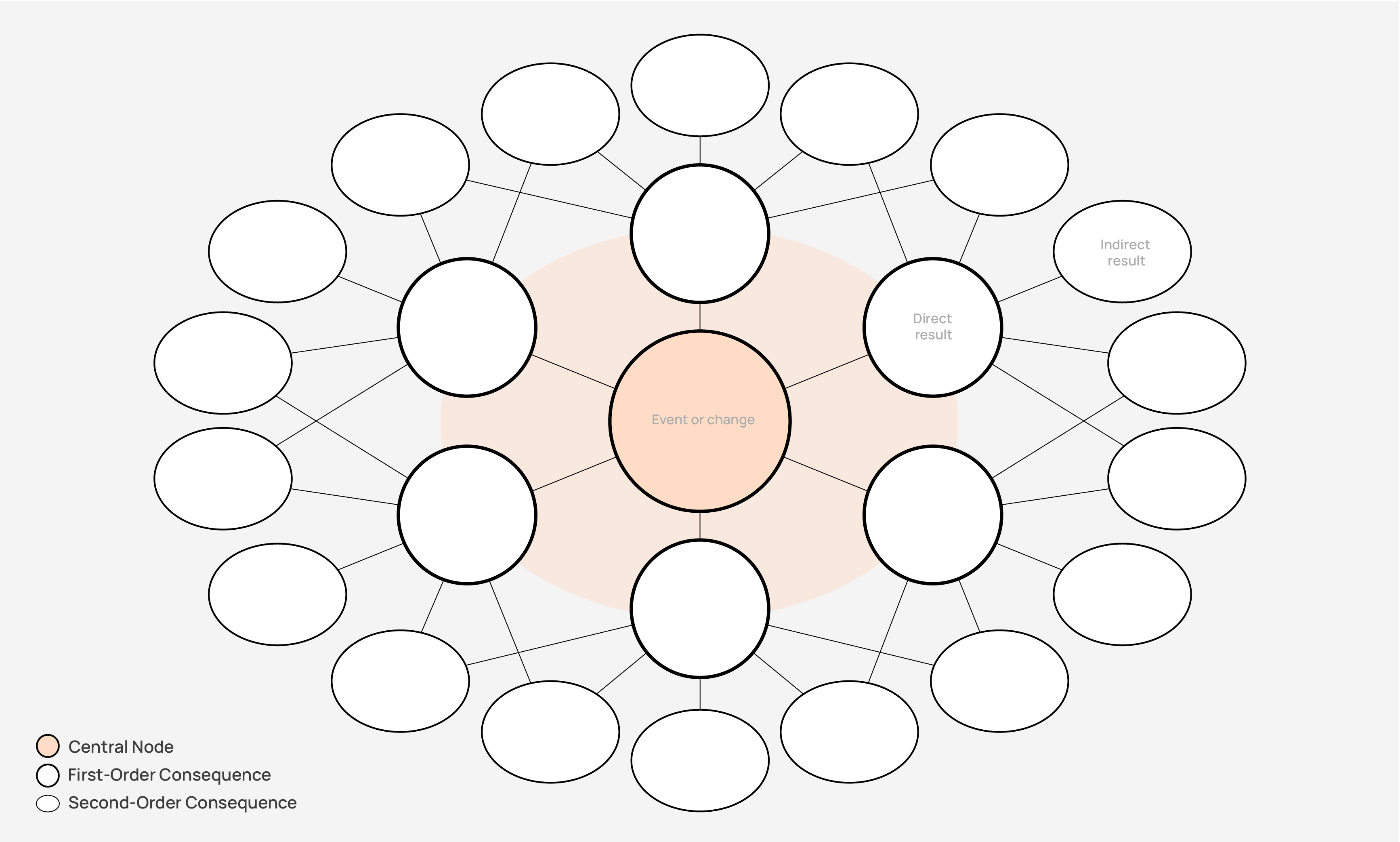The Futures Wheel
The Futures Wheel is a visual tool used to explore the consequences of a particular event or change.
It supports structured brainstorming by mapping out potential impacts in concentric circles, helping users to consider both immediate and long-term effects.
Key concepts for the Futures Wheel include:
Central Node: The main event or change being analysed, placed at the centre.
First-Order Consequences: Immediate impacts that result directly from the central event, arranged around it.
Second-Order Consequences: Indirect impacts that stem from the first-order consequences
Interconnections: Links between different consequences, showing how changes can affect each other
The results
- A clear visualisation of potential impacts and consequences of decisions.
- Identification of both positive and negative second- and third-order effects.

When to use it
Strategic Formulation: When undertaking strategy formulation and seeking to understand risks or opportunities
Exploring New Trends: When analysing how emerging trends might impact your industry or organisation
Innovation and R&D – When exploring the new technologies or innovations.
Strengths
Visual
Prompts broader thinking
Can help explore emerging trends or significant events deeply
Weaknesses
Can be subjective
Requires research or deep knowledge to get meaningful insights
How to use it?
What do I need to start?
Information relevant to the organisation or industry. For example:
- Key data on the central event or change
- Relevant industry reports and forecasts
- Historical data and trends
How to use it?
Who to involve?
Creating a Futures Wheel is best done with a team. Consider involving:
- People who have expertise in the specific area being analysed
- People who are accountable for setting the strategic direction of the organisation
- People who can help translate the strategic direction into initiatives
- People who represent diverse perspectives
Step by step
1
Identify the central event or change
Define the main event or change. Ensure that the central event is specific and relevant to the organisational objectives. Ask questions like:
- What is the main change or event we are examining?
- Why is this event significant?
- How does this event align with our goals?
2
Determine if research is required and what approach is best
Assess whether research is required to understand the potential impacts of the event fully. Ask questions like:
- What don’t we know?
- What assumptions are we making?
- How complex are the potential impacts?
- What information already exists?
Consider the following approaches:
Literature Review: Ideal for quickly gathering existing knowledge from published sources. Choose this if you’re on a tight budget or need general background information.
Expert Interviews: Great for gaining deep insights from specialists, especially if the topic is complex or under-researched.
Data Analysis: Use this to identify trends and validate assumptions with hard data. Best for situations requiring evidence-based conclusions.
Survey Stakeholders: Useful for capturing diverse opinions from people directly affected by the change. This is helpful when understanding practical, on-the-ground impacts.
When defining the research approach, ask questions like:
- What’s our budget and timeline?
- What do we need to understand potential impacts enough to move forward?
Undertake, analyse and communicate insights gathered through the research
3
Brainstorm first-order consequences
Identify and document impacts directly resulting from the central event.
When documenting impacts, avoid using generic language. Ask questions like:
- How exactly will this impact our operations, employees, or customers?
- What measurable changes can we expect as a result of this?
4
Identify second-order consequences
Review the first-order consequences and consider what the impacts may be of those changes. Ask questions like:
- What secondary or long-term changes could this trigger?
- How will this impact other parts of the organisation or system?
- How could this impact key stakeholders?
5
Connect related consequences to show interconnections
Draw lines to connect related consequences, illustrating how one change leads to another. Ask questions like:
- How are the consequences interconnected?
- What patterns or relationships are emerging?
6
Review and analyse the complete wheel
Examine the entire Futures Wheel to identify key insights, potential risks, and opportunities. Ask questions like
- What are the most significant insights from the Futures Wheel?
- How can we mitigate potential risks?
- What opportunities can we leverage from these insights?
7
Determine next steps
Plan next steps based on the analysis. Ask questions like:
- What actions should be taken to address these consequences?
- Who will be responsible for implementing these actions?
- What resources or support are needed to move forward?
- How will we measure progress or success in addressing these impacts?
- What potential challenges or barriers could arise, and how will we mitigate them?
- What’s the timeline for these next steps?